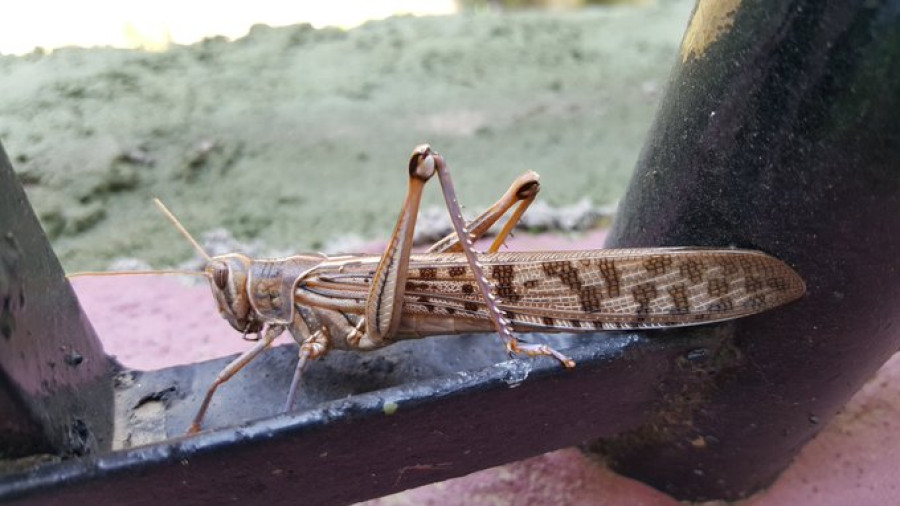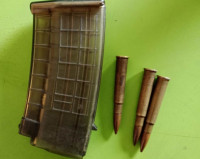National
No locust swarms in Nepal, but officials warn that the threat isn’t over yet
While current swarms are unlikely to arrive here, officials say that weather conditions and the size of the next generation will determine whether they reach Nepal.
Chandan Kumar Mandal
On Tuesday, a picture of a very large grasshopper in Sankhamul posted to social media left many wondering if the locust swarm that has devastated parts of Asia, Africa and the Middle East was on its way to Nepal. More than a week ago, a similar insect had been sighted around Kathmandu’s Bhotahity and there were anecdotal reports from Patan.
Government officials, however, have dismissed fears, saying there is no indication that locust swarms are headed in Nepal’s direction, and that there is no need to worry.
Locusts are slightly larger than other grasshoppers in size, although they come from the same grasshopper family. They can be differentiated based on colour. Locusts, which are red, yellow or black during their solitary phase, later turn grey while swarming or migratory stage. When they are hungry during the solitary phase, they start rubbing legs before flying.
What further differentiates them is their behavioural states. While grasshoppers are solitary creatures, locusts can exist in two different behavioural states—solitary and gregarious, which is when they form swarms.
Once their swarms subside, they can disperse and go elsewhere, which is most likely happened with the insect seen in Sankhamul, according to Ram Krishna Subedi, senior plant protection officer at the Plant Quarantine and Pesticide Management Centre.
It is likely that a few hundred locusts that broke off from the swarms in India could’ve ended up in Nepal, he said.
However, Subedi was unable to verify conclusively whether the insects pictured were voracious locusts or just plain, harmless grasshoppers.
“We could not say whether they are locusts or not, but our conclusion is that locusts swarms have not entered the country yet,” Subedi, who is also the spokesperson at the centre, told the Post.
With millions of hectares of land currently under assault by billions of locusts in Africa, China, Pakistan, and India, the Nepal government had formed a five-member task force in late May to study the possibility of their invading in Nepal.
A preliminary study by the task force had said that locusts are unlikely to enter Nepal.
But experts like Subedi, who worked closely with the government task force and also jointly published a factsheet on the desert locust, said that factors like wind movement, weather conditions and where the insects breed next will determine whether Nepal will see swarms in the future.
“Locusts’ swarms in India have moved towards the southeast and reached around Odisha. Had they been flying in a northeast direction, they would have come towards Nepal,” said Subedi. “But we also have to wait for the next generation of insects, which is predicted to breed in the Indian state of Rajasthan.”
India, which is in the midst of a swarm, is already bracing for the next wave, predicted as early as late June or early July. Locusts fly in swarms and can travel around 150km in a day. During their flights, a small flock of locusts, Schistocerca gregaria, can quickly destroy agricultural produce in a day that can feed 2,500 people.
A swarm includes a minimum of 40 million locusts and can span over 30km long and 2km wide, according to Subedi.
Although locusts are mostly solitary creatures like grasshoppers, when they enter their swarming phase they can cause severe damage to farmland. The ongoing locust attack could threaten food security in South Asia region.
According to Subedi, Nepal will have to wait up to at least June 15 to be certain if the locust will miss us. This will depend on their number after breeding, weather conditions and then winds direction.
“We have to see what will be the number of locusts after their breeding in Rajasthan. If the size is huge then we will have to stay on alert. The government agencies are receiving regular updates from the UN’s Food and Agriculture Organisation regarding locust movement in India,” said Subedi. “But the chances of their entry into Nepal are lower because of the approaching monsoon. In rainy and overcast conditions, locusts cannot travel long.”
Authorities in Nepal have also predicted that the ongoing generation of locusts, which is wreaking havoc in parts of India, won’t reach in Nepal because most will die along on the way. Locusts have a life cycle of at most eight weeks.
“These locusts breed twice in a year—in the winter and summer. As they travel, the group becomes smaller and also die due to controlling measures on the way,” said Subedi. “With weatherly disturbances and a small size, they may not reach Nepal. But a large group supported by winds from the east could bring them here.”




 7.12°C Kathmandu
7.12°C Kathmandu















